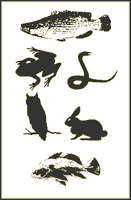Nebraska Cooperative Fish and Wildlife Research Unit

Nebraska Cooperative Fish and Wildlife Research Unit: Staff Publications
Date of this Version
2021
Citation
Lavretsky, P., Wilson, R. E., Talbot, S. L., Sonsthagen, S. (2021). Phylogenomics reveals ancient and contemporary gene flow contributing to the evolutionary history of sea ducks (Tribe Mergini). Molecular Phylogenetics and Evolution, 161, 107164
doi:10.1016/j.ympev.2021.107164
Abstract
Insight into complex evolutionary histories continues to build through broad comparative phylogenomic and population genomic studies. In particular, there is a need to understand the extent and scale that gene flow contributes to standing genomic diversity and the role introgression has played in evolutionary processes such as hybrid speciation. Here, we investigate the evolutionary history of the Mergini tribe (sea ducks) by coupling multi-species comparisons with phylogenomic analyses of thousands of nuclear ddRAD-seq loci, including Z-sex chromosome and autosomal linked loci, and the mitogenome assayed across all extant sea duck species in North America. All sea duck species are strongly structured across all sampled marker types (pair-wise species ΦST > 0.2), with clear genetic assignments of individuals to their respective species, and phylogenetic relationships recapitulate known relationships. Despite strong species integrity, we identify at least 18 putative hybrids; with all but one being late generational backcrosses. Most interesting, we provide the first evidence that an ancestral gene flow event between long-tailed ducks (Clangula hyemalis) and true Eiders (Somateria spp.) not only moved genetic material into the former species, but likely generated a novel species — the Steller’s eider (Polysticta stelleri) — via hybrid speciation. Despite generally low contemporary levels of gene flow, we conclude that hybridization has and continues to be an important process that shifts novel genetic variation between species within the tribe Mergini. Finally, we outline methods that permit researchers to contrast genomic patterns of contemporary versus ancestral gene flow when attempting to reconstruct potentially complex evolutionary histories.
Lavretsky MPE 2021 Phylogenomics reveals SUPPL 2.xlsx (9 kB)
Lavretsky MPE 2021 Phylogenomics reveals SUPPL 3.xlsx (105 kB)
Lavretsky MPE 2021 Phylogenomics reveals SUPPL 4.docx (19 kB)
Lavretsky MPE 2021 Phylogenomics reveals SUPPL 5.xlsx (79 kB)
Included in
Aquaculture and Fisheries Commons, Environmental Indicators and Impact Assessment Commons, Environmental Monitoring Commons, Natural Resource Economics Commons, Natural Resources and Conservation Commons, Water Resource Management Commons


Comments
U.S. government work